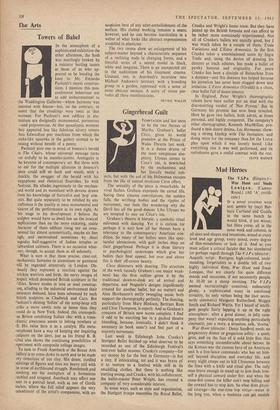the Arts Towers of Babel
Paolozzi puts one in mind of lonesco's herald in The Chairs, whose universal message turns )ut artfully to be mumbo-jumbo. Ambiguity is he keynote of contemporary art. But those with lo ear for the multiple allusions in lonesco's piece could still sit back and watch, with a :huckle, the swagger of the herald with his negaphone and rhetorical flourishes. So with ?aolozzi. He alludes ingeniously to the mechan- , .sed world and its wasteland with devices drawn from his knowledge of Surrealist and 'pop' con- :eits. But quite separately to be relished by any :raftsman is the quality at once monumental and nzarre of the performance in its own right, At his stage in his development I believe the sculptor would have us dwell less on the ironical mplications than on the more enduring, stable :haracter of these edifices rising tier on orna- mented tier almost symmetrically, maybe six feet ugh, and surmounted sometimes by short ,agodas half-suggestive of Indian temples or 3dwardian cabinets. There is no occasion what- ..Ner, though, to accept them at all solemnly. What is sure is that these precise, clear-cut, • nechanistic fantasies in aluminium or gunmetal vill be regarded attentively in London. Ob- 'iously they represent a reaction against the tricken warriors and birds, the nervy images of 1espair which dominated British sculpture in the 17ifties. Severe modes in iron or steel construe- • ion, alluding to the industrial environment their iresences demand, have been advanced by such Iritish sculptors as Chadwick and Caro. But Paolozzi's shining 'follies' of the scrap-heap still ,trike a more exotic note at home than they ,vould do' in New York. Indeed, this cosmopoli- an Briton combining Italian chic with a trans- itlantic awareness seems to belong nowhere at ill. His value here is as a catalyst. His meta- norphoses have a way of keeping our inquiring -culptors on the alert, just as his friend R. B. iCitaj also shows the contjnuing possibilities of _xperiment with composite collage images.
To turn to Frank Auerbach at the Beaux Arts .3allery is to come down to earth and to be made ery conscious of our clay. His dense, curdled laintings of figures and sites are heavy still with 'le sense of earthbound struggle. Rembrandt and ;omberg are his exemplars of a humanism roubled and resigned. Auerbach may affect one lost in a portrait head, such as one of Gerda loehm, where the full relief appears the very • mbodiment of the artist's compassion, with no suspicion here of any after-embellishment of the surface. His clotted working remains a snare, however, and he can become inarticulate, in a welter of what looks like abstract expressionism modelled in plasticine.
The two rooms show an enlargement of his subject-matter beyond a characteristic sequence of a reclining nude in changing forms, and a forceful series of a seated model in black, white and sanguine. There is an unexpected stir in the auditorium of his Gaumont cinema. Unusual, too, is Auerbach's incursion into Michael Andrews's territory with a brooding group in a garden, oppressed with a sense of some obscure menace. A unity of vision per- vades all these manifestations.
NEV ILE WALLIS






























 Previous page
Previous page